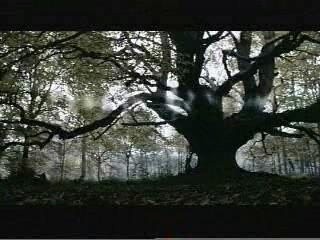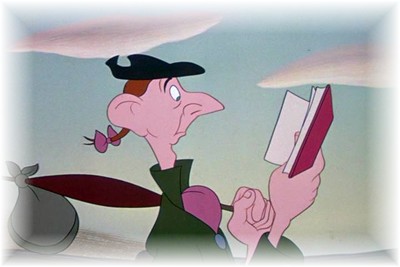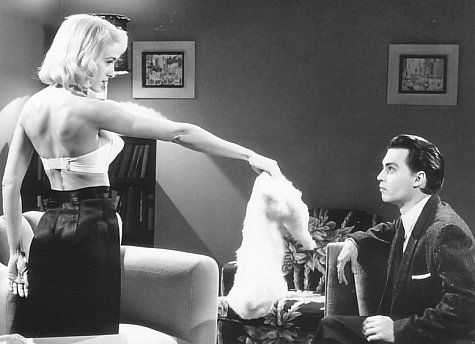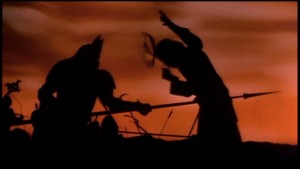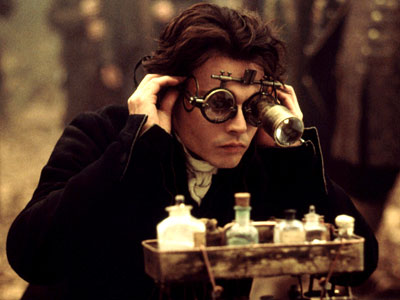From the November 19, 1999 issue of the Chicago Reader. — J.R.
Sleepy Hollow
*** (A must-see)
Directed by Tim Burton
Written by Andrew Kevin Walker and Kevin Yagher
With Johnny Depp, Christina Ricci, Miranda Richardson, Michael Gambon, Casper Van Dien, Jeffrey Jones, and Christopher Walken.
Tim Burton’s new movie is gorgeous — shot by shot it may be the most impressive thing he’s done. So I hope I’m not being too disrespectful if I balk at the idea that his movie is based on Washington Irving’s “The Legend of Sleepy Hollow.”
I was an English major in college and graduate school, yet I can’t remember reading a word of Irving until I read this wonderful 180-year-old story a few days after seeing the movie. He may be one of America’s great writers, but apparently few people still read him, even though his prose is clear and vivid. Take the seventh paragraph of “The Legend of Sleepy Hollow,” for instance:
“I mention this peaceful spot [Sleepy Hollow] with all possible laud for it is in such little retired Dutch valleys, found here and there embosomed in the great state of New York, that population, manners, and customs, remain fixed, while the great torrent of migration and improvement, which is making such incessant changes in other parts of this restless country, sweeps by them unobserved. They are like those little nooks of still water, which border a rapid stream, where we may see the straw and bubble riding quietly at anchor, or slowly revolving in their mimic harbor, undisturbed by the rush of the passing current. Though many years have elapsed since I trod the drowsy shades of Sleepy Hollow, yet I question whether I should not still find the same trees and the same families vegetating in its sheltered bosom.”
Those who find on-line texts more user-friendly than books can find this story at ftp://uiarchive.cso.uiuc.edu/pub/etext/gutenberg/etext92/sleep10.txt, though the story’s final postscript is omitted, for reasons that escape me. Those who prefer books can find it in Peter Lerangis’s novelization of Sleepy Hollow, where it’s included as a kind of idle afterthought, or in Irving’s 1848 collection The Sketch Book of Geoffrey Crayon, Gent. If you assume that Burton’s movie is an adaptation of this story, read it and weep.
Admittedly, there’s an Ichabod Crane in Burton’s movie — though here he’s a New York detective (Johnny Depp), not a local schoolteacher and choirmaster — and a farmer’s daughter named Katrina Van Tassel (Christina Ricci) who takes a shine to him, and a burly horseman who competes for her favor called Brom Van Brunt (Casper Van Dien). The period and the town are roughly the same, and Ichabod gets menaced by a headless horseman. But after that the resemblances cease. In fact, the two stories are for the most part based on opposite premises. It’s clear in the Irving story, though the narrator remains coy about it, that the headless horseman is Brom in disguise, and he so badly scares the impressionable Ichabod when he’s on his way home from a party at the Von Tassels’ that he disappears from town, allowing Brom to marry Katrina. But in Burton’s version there really is a headless horseman (an uncredited Christopher Walken) who’s already beheaded several locals (including Martin Landau in a precredits sequence), not to mention a trite flashback out of a Hammer horror movie of the 50s or 60s about What Made Him That Way. (The screenwriter is Andrew Kevin Walker, who wrote the contemporary serial-killer movie Seven and, more recently, Fight Club; the screen story is credited to Walker and Kevin Yagher, a makeup artist and special-effects expert who’s also done some direction on TV’s Tales From the Crypt.)
Even before I read the Irving story, I suspected the movie’s claim to be an adaptation was bogus. Why? In part because of Walt Disney’s The Adventures of Ichabod and Mr. Toad (1949), which for all its obvious and considerable liberties — including jitterbug songs performed by Bing Crosby and slapstick with domestic animals — actually turns out to be an adaptation; unlike the Burton version, it even bothers to integrate bits of Irving’s language, in Crosby’s narration as well as in the songs. Some of the essence of the Irving paragraph quoted above finds its way into the Disney cartoon, but it’s hard to find any trace of it in Sleepy Hollow. If James Agee had still been reviewing movies for the Nation in 1949, I’m sure he would have condemned The Adventures of Ichabod and Mr. Toad — two half-hour cartoons based on the Irving story and The Wind in the Willows — for its vulgarity and anachronisms, and he might have been right. It’s a mark of the distance we’ve traveled in half a century that the 30-minute Disney cartoon now looks like a model of faithful adaptation in comparison to Sleepy Hollow. Complexities in the characterizations — Ichabod is something of a gold digger, for instance, interested in Katrina for her money as well as her beauty — make it into the kiddie version. Burton’s R-rated movie, bent on keeping its star hero spotless, wouldn’t dream of such a thing.
Like Don Quixote, “The Legend of Sleepy Hollow” is a bittersweet parable about the perils of the imagination as it’s affected by reading or hearing stories. (One of Ichabod’s favorite books, in which “he most firmly and potently believed,” is Cotton Mather’s History of New England Witchcraft.) A lineage from Cervantes is clear in the descriptions of Crane’s lanky physique and “his broken-down plow horse” named Gunpowder, which recalls Quixote’s Rocinante. As Crane prepares to mount Gunpowder en route to the Van Tassels’ “quilting frolic,” Irving even likens him to “a knight-errant in quest of adventures.” But in the postliterate context defined by Burton, a reader’s or viewer’s imagination is secondary to the glories of visual effects, so the only headless horseman that matters isn’t the one inside Crane’s head — or our own, for that matter — but the one up there on the screen.
Another reason I knew Sleepy Hollow wasn’t an adaptation was that Ichabod and the headless horseman had seeped into my consciousness as part of mainstream American culture in the 50s, much as certain pop-culture figures seep into people’s heads today. Back then, you didn’t have to be literary or even especially literate to know something about the story. “Stop pawing me,” says Eula Varner, a fairly simple soul, to the schoolteacher Labove, who’s trying to seduce her in William Faulkner’s The Hamlet, adding petulantly, “You old headless horseman Ichabod Crane.” The comic incongruity of such a marriage of opposites could register in a midcentury American novel because at that time enough people knew who both Crane and the headless horseman were. Today, not even the publicists who put together the Sleepy Hollow press book or some of the journalists who’ve interviewed Burton about the movie — check out the magazine Starburst for a good example — seem to know the original story or who its characters are. Apparently the very prospect of reading this 40-page story is more than they can handle.
Does Irving’s story involve a guy from 1799 Manhattan who tries to track down a serial killer in upstate New York? Is it about something supernatural, about a headless horseman who lives inside a tree trunk? No, but that’s what the movie is about.
Tim Burton was born 15 years later than I was, in 1958, and I’m fascinated by what I regard as a historical divide separating his notion of fidelity from mine. It’s not that Burton isn’t concerned about his models and touchstones — he obviously cares passionately about them. Yet here he seems indifferent to his alleged source — which isn’t the same thing as his models or his touchstones.
If this sounds muddled, I’m not sure whether I’m to blame or Burton. Consider, for example, what a publicist attributes to him in the movie’s press book (my comments are added in square brackets): “‘I’m a big fan of all the Hammer horror films of the 50s and 60s, and this script has a lot of classic beautiful horror images,’ says Burton. ‘What I liked about the script is that it’s respectful of the original story [the point at which our opinions radically diverge] but takes it into new territory. It also has a great mix of drama and humor. I had known the story of the Headless Horseman mainly from the Disney cartoon. [What does ‘mainly’ mean? Is Burton indicating he might have read a Classics Illustrated version of the story? Did he read the Irving story and then forget it?] It’s one of the few American horror stories. [Maybe, but as critic Malcolm Bradbury points out, it’s based on a German folktale, just as Irving’s ‘Rip Van Winkle’ is.] I don’t know what its power is exactly, but there’s a certain reason why people always remember the Headless Horseman. He’s a great symbol. [Of what?]” In other words, Burton is faithful to some of the images in the Disney cartoon but not to their function or meaning in either the Irving story or the Disney — which also entails an overhaul of Ichabod Crane’s character. (In Irving and Disney, he’s gullible from the start; in Burton, he loses his skepticism as soon as he sees a real headless horseman and witnesses an actual beheading, which is early on.)
The same press book notes that costume designer Colleen Atwood’s “research focused on period paintings and visual descriptions of costumes from books. ‘There were no existing photographs,’ comments Atwood, ‘but since this film is not a history lesson, the work becomes very impressionistic.'” By “no existing photographs,” I take it that Atwood or some publicist is trying not to insult any journalist who thinks there might have been 1799 photographs that didn’t survive — proving that the press notes aren’t a history lesson either. Someone might also have pointed out that people didn’t have E-mail or faxes back then either, which is why Katrina’s father has to send a letter to New York by snail mail requesting the services of a detective.
Burton’s Ed Wood shows that he couldn’t have cared less about accuracy when it came to Edward D. Wood Jr.’s life in the 50s or the 50s themselves. Yet when dealing with Wood’s work — films such as Glen or Glenda?, Bride of the Monster, or Plan 9 From Outer Space — Burton was as dedicated as a Talmudic scholar to getting things exactly right; he gave the impression that he was dealing with holy writ. In Mars Attacks! Burton’s selective fidelity is even more striking; the film displays loving exactitude in reproducing a series of bubble-gum trading cards Topps briefly issued in 1962 and cheerful yet unmitigated scorn toward practically everything else American civilization had to offer over the ensuing 34 years, with particular contempt reserved for presidential politics.
There’s something undeniably touching about such unreasonable passion and devotion, and I suppose some of the same sort of piety can be found in Sleepy Hollow. All these movies have the fervent fanaticism of a cult taste projected into the mainstream with affection as well as confidence. Yet here Burton’s fidelity is exclusively to the period feeling he gets from disreputable Hammer horror films (which entails some relation to the period of Hammer’s literary sources — Frankenstein was published the same year “Rip Van Winkle” was written) and a few images culled from Ichabod and Mr. Toad. When it comes to one of America’s great stories, Burton obviously couldn’t care less.
For all his considerable gifts as a visual artist, Burton is only secondarily a storyteller, which is why someone else generally writes the scripts. Like many of the best movie comics, he tends to think in terms of shots and sequences rather than longer stretches. (To some extent this is both the glory and the limitation of Bram Stoker’s Dracula, directed by Francis Ford Coppola, perhaps the horror movie Sleepy Hollow most resembles; Coppola, incidentally, served as one of Sleepy Hollow‘s executive producers.)
If Burton’s writers had come up with anything even a fraction as good as Irving, I’d have no cause for complaint. But they’ve delivered such a hackneyed and hokey hand-me-down — a serial-killer-movie plot with a predictably unpredictable twist at the end — that I’ve already forgotten most of it. Maybe this doesn’t matter as long as the beautiful images keep coming, and thanks to Burton’s artistry, they do — even if his publicists are so oblivious to this virtue that only one of the many stills given to the press, the one [that originally ran] with this review, even hints at such a distinction. But beauty separated from meaning — apart from mood and isolated bursts of emotion — isn’t nearly as likely to be as memorable as beauty arising from and commingling with a good story. That’s why Sleepy Hollow is a ravishing visual experience, a pretty good (if far from challenging) vehicle for some talented American and English actors, and a mediocre serial-killer and horror movie. It looks a lot better than any Hammer horror movie I ever remember seeing — just as Ed Wood looks much better than any Wood movie that comes to mind. But I doubt I’ll be thinking much about Sleepy Hollow a month from now.


